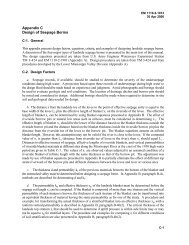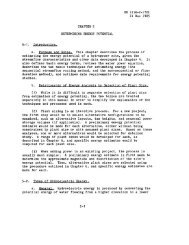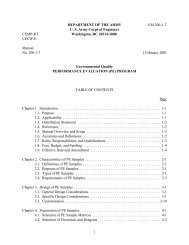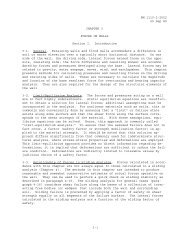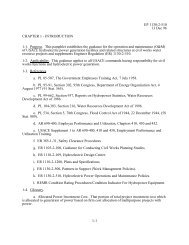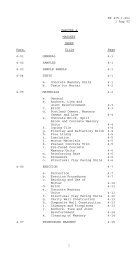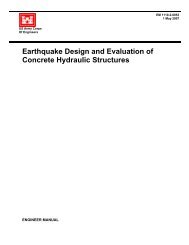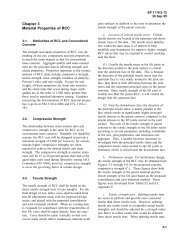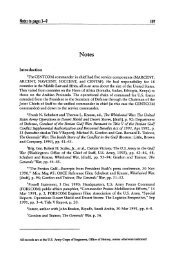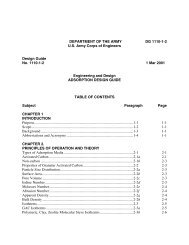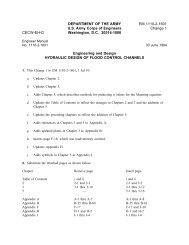em2901.chp:Corel VENTURA - Publications, US Army Corps of ...
em2901.chp:Corel VENTURA - Publications, US Army Corps of ...
em2901.chp:Corel VENTURA - Publications, US Army Corps of ...
You also want an ePaper? Increase the reach of your titles
YUMPU automatically turns print PDFs into web optimized ePapers that Google loves.
EM 1110-2-2702<br />
1 Jan 00<br />
where<br />
3-14<br />
a. Design basis. The basic safety check in LRFD may be expressed mathematically as<br />
Q Rn<br />
(3-1)<br />
i<br />
ni<br />
i = load factors that account for variability in the corresponding loads<br />
Qni = nominal load effects defined herein<br />
= reliability factor as defined in EM 1110-2-2105<br />
= resistance factor that reflects the uncertainty in the resistance for the particular limit state and, in<br />
a relative sense, the consequence <strong>of</strong> attaining the limit state.<br />
Rn = nominal resistance.<br />
For the appropriate limit states (paragraph 3-4.c), all structural components shall be sized such that the<br />
design strength Rn is at least equal to the required strength iQni. The design strength shall be<br />
determined as specified in paragraph 3-4.c. The required strength must be determined by structural<br />
analysis for the appropriate load combinations specified in paragraph 3-4.b.<br />
b. Load requirements.<br />
(1) Loads. Loads that are applicable to tainter gate design include gravity loads, hydrostatic loads,<br />
operating loads, ice and debris loads, and earthquake loads. Reactions are not listed below or in the load<br />
cases. Reactions loads are not factored since they are determined from equilibrium with factored loads<br />
applied. As a result, reaction forces reflect the load factors <strong>of</strong> the applied loads.<br />
(a) Gravity loads. Gravity loads include dead load or weight <strong>of</strong> the gate (D), mud weight (M), and ice<br />
weight (C), and shall be determined based on site-specific conditions.<br />
(b) Hydrostatic loads. Hydrostatic loads consist <strong>of</strong> hydrostatic pressure on the gate considering both<br />
upper and lower pools. Three levels <strong>of</strong> hydrostatic loads are considered. The maximum hydrostatic load<br />
H1 is defined as the maximum net hydrostatic load that will ever occur. The design hydrostatic load H2 is<br />
the maximum net hydrostatic load considering any flood up to a 10-year event. The normal hydrostatic<br />
load H3 is the temporal average net load from upper and lower pools, i.e., the load that exists from pool<br />
levels that are exceeded up to 50 percent <strong>of</strong> the time during the year.<br />
(c) Gate lifting system (operating machinery) loads. Operating machinery is provided to support gates<br />
during lifting or lowering operations. Under normal operating conditions, the machinery provides forces<br />
necessary to support the gate, and for the load cases described herein, these forces are treated as reaction<br />
forces. Loads Q are machinery loads for conditions where the machinery exerts applied forces on an<br />
otherwise supported gate (paragraph 3-4.b(2)(f)). There are three levels <strong>of</strong> loads applied by the operating<br />
machinery to the gate. The hydraulic cylinder maximum downward load Q1 is the maximum compressive<br />
downward load that a hydraulic hoist system can exert if the gate gets jammed while closing or when the<br />
gate comes to rest on the sill. The hydraulic cylinder at-rest load Q2 is the downward load that a hydraulic




